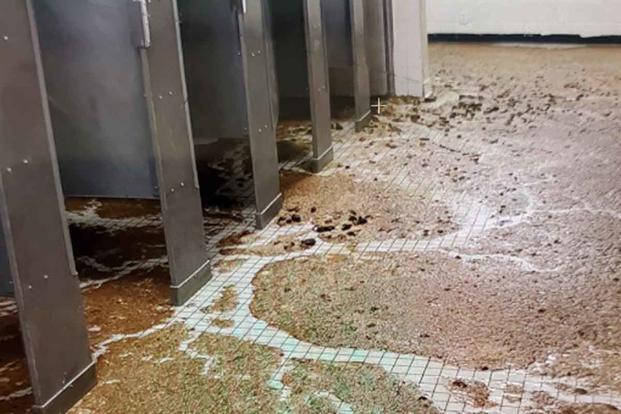Military barracks with plumbing so bad that the entire building smelled of methane, and water so disgusting it wasn’t considered safe to drink.
Those were among the findings by the Government Accountability Office after it visited 12 military installations to examine the living conditions of troops in base housing. The watchdog agency published the conditions in a scathing new report, confirming complaints made by many service members for years.
The nearly 100-page report was rife with examples of substandard conditions. Pests such as bedbugs and roaches were a common issue at six of the bases that the GAO visited. Several bases had severe issues with security in the buildings, to the point that service members said that they were unable to lock their doors at night and squatters had moved in.
Read Next: Negligent Discharge Killed Marine Training at Camp Pendleton Last Month, Navy Report Indicates
The GAO concluded that leaders at the Pentagon are not only failing to provide oversight — instead choosing to largely punt the issue to the branches — but they also don’t consider it a priority. The result has been bureaucratic finger-pointing, with no one office or leader willing to own the issue.
Therefore, the military’s youngest and most vulnerable troops — tens of thousands of service members — who depend on barracks housing have been forced to clean up dangerous, crowded and disgusting rooms themselves.
While it is unclear exactly how many troops now live in substandard barracks, the report says that “at least thousands of service members are affected.” The Navy and Marine Corps reported to the GAO that about 5,000 sailors and 17,000 Marines lived in substandard barracks as of March.
Reports of poor barracks conditions are not new. Accounts from service members checking into moldy or disgusting barracks rooms crop up on social media regularly. Sometimes, those incidents become widespread or horrid enough that they draw attention from the media and, in turn, military leaders.
Military.com, just in the last two years, has reported on issues in the barracks from soldiers stationed at Fort Stewart in Georgia to Fort Bragg, now Fort Liberty, in North Carolina, as well as problems for sailors at bases like Walter Reed National Military Medical Center in Bethesda, Maryland; the air station at Key West, Florida, and ships undergoing overhaul at Newport News Shipyard in Newport News, Virginia.
‘Continuous Misery’
The 12 military installations visited by the GAO are not named in the report. The agency spoke with service members and leaders in discussion groups. The report says the sample size is small and not generalizable to all military installations, but that it offers important information on what troops experience.
The problems it cites make for grim reading.
At five different bases, service members told investigators that they had problems with water quality in the barracks, with one group reporting that their water “is often brown and does not appear safe for drinking.”
One base had to shutter a barracks building because its plumbing had become a breeding ground for Legionella — the bacteria that can cause Legionnaires’ disease, a condition that kills one in 10 people affected, according to the Centers for Disease Control and Prevention.
When investigators asked about other barracks on the base, officials said that they didn’t run water tests on them because they were not required to do so.
Another pervasive problem was the lack of air conditioning, especially at bases that are located in hot or humid areas.
At one barracks on a base in the Washington, D.C., area, about 25% of rooms had broken air-conditioning systems. Service members on that base described living in the barracks “as continuous misery” to investigators.
A service member told investigators that trying to sleep in their barracks room with broken air conditioning “is like standing in the sun all night.” Others reported their rooms could reach more than 90 degrees Fahrenheit when the air conditioning went out, a frequent occurrence.
Conditions in some barracks were so dire that they lacked even the most basic necessities like windows and lights.
Officials from the GAO found that one barracks building at the base in the Washington, D.C., area “had 12 broken windows, 150 rooms without adequate lighting, and a broken elevator.”
In fact, the lack of secured windows and doors has led to squatting issues at some bases.
Investigators reported that officials at two installations told them of squatters living in vacant barracks rooms. At one base, investigators saw the problem firsthand, even going so far as to include a photo of the room that was occupied illegally.
The severity of the problems — as well as the seeming inability of military officials to fix them — has meant service members either choose to or are ordered to take it upon themselves to improve their living conditions.
For example, as evidenced by photos in the report, as well as social media posts, service members often resort to purchasing their own air-conditioning units. Meanwhile, troops told investigators that “during cold winter months, they have to purchase their own portable space heaters, despite the fire risk, because of broken heating systems.”
At three installations, officials told the GAO that “service members are generally responsible for pest control, or for removing hazardous material from barracks, such as mold and sewage.”
Barracks managers at multiple bases said that they had to organize “working days for service members to repaint external or internal walls, replace ceiling tiles, or clean up significant sewage overflow.”
In one of the most extreme examples, one installation told officials that “service members are responsible for cleaning biological waste that may remain in a barracks room after a suicide.”
The result is either unnecessary out-of-pocket spending by some of the lowest-paid members of the service or injuries.
One service member in the report said that “regularly cleaning mold with harsh chemicals caused them chronic wheezing.”
In April, Military.com reported on cases of nearly a dozen soldiers at Fort Liberty and Fort Stewart who reported being admitted to the hospital for coughing up blood or feared they were developing respiratory issues — symptoms consistent with reactions to prolonged exposure to black mold.
Army Secretary Christine Wormuth told lawmakers in April that she’s “seen some barracks quite frankly I wouldn’t want my daughters to live in.”
‘It Was Not a Priority’
How conditions in the barracks were allowed to deteriorate is partially the result of the military’s hodgepodge of evaluation systems, metrics and standards, which has made it difficult for leaders to know how bad conditions truly are in some locations, according to the GAO.
As an example, investigators toured one barracks that was deemed uninhabitable yet at the time of its shuttering, “its condition score was above 90, according to service documentation.”
Each service gets to decide how often to have the barracks assessments, so the most frequent is every 3 years and the longest is every 10, the GAO report said. Who conducts these assessments also varies.
As a result, the report echoes what some senior garrison or division leaders have told Military.com — that understanding the scope of the problem has been difficult.
At Fort Liberty, for example, Military.com reported on the poor conditions of Smoke Bomb Hill Barracks, and senior leaders with XVIII Airborne Corps told reporters they did not have the tools to track all the issues with mold in living quarters. Twelve of those barracks were set for demolition and roughly 1,200 soldiers were relocated after the decades of neglect of those buildings drew the ire of senior Army leaders.
Inside the Defense Department, there is little to motivate the services to do better by their junior enlisted.
The Pentagon’s standards for a barracks room are minimal — broadly mandating that service members have between 72 and 90 square feet of space per person, no more than two to a bedroom, and that there be a food preparation area.
There are no health or safety requirements that prevent installations from assigning service members to live in substandard barracks rooms.
The report found that the services uniformly meet only the square footage requirement.
The Pentagon’s guidance allows the services to exempt themselves — issue a waiver — from even this minimal requirement and set their own rules. The Army, Navy and Marine Corps all consider their own rules to exempt them from the Defense Department’s requirements.
For example, in the most extreme case, investigators concluded that “the Army’s standards constitute the Army’s waiver” and the service does not issue waivers when individual barracks fail to meet Pentagon standard because it doesn’t follow it and, thus, doesn’t need an exemption.
Meanwhile, several offices that report to the defense secretary either say the impact of barracks conditions on troops is not their problem or they removed ways to learn more about the situation.
Staff of Gil Cisneros, who was at the time the under secretary of defense for personnel and readiness and the main adviser to the defense secretary on quality-of-life matters, told the investigators that “they do not monitor the effects of barracks conditions because they believe that barracks conditions are a less important factor affecting service members’ quality of life when compared to other factors.”
The Pentagon’s Office of People Analytics removed housing satisfaction questions from its annual, military-wide “Status of Forces” survey in part because “it was not a priority.” Staff for Patricia Coury, the current deputy assistant secretary of defense for housing, told the GAO officials her office wasn’t consulted.
Meanwhile, military service leaders have often said publicly that the core of the problem is funding.
The Army, the Pentagon’s largest service with the largest portfolio of barracks, spends about $1 billion per year on that base housing, and its top leaders have been vocal on the need for more resources to build new barracks.
A 2022 report from the Congressional Budget Office found that fixing up barracks at only Schofield Barracks, Hawaii, and Fort Liberty, installations that have some of the lowest-quality barracks, would cost $11 billion.
Congress has also been made aware of the issue over the years, yet major investments in quality-of-life improvements for troops continue to take a backseat to other issues, such as weapons procurement, on Capitol Hill.
In 2022, despite a string of housing scandals, including one that was linked to a spate of suicides, the Navy told Congress that it was prioritizing other construction goals — namely shipyards — instead of barracks repairs or upgrades.
— Rebecca Kheel contributed to this report.
— Konstantin Toropin can be reached at konstantin.toropin@military.com. Follow him on Twitter @ktoropin.
— Steve Beynon can be reached at Steve.Beynon@military.com. Follow him on Twitter @StevenBeynon.
Related: These Soldiers Say Mold in Barracks Isn’t Just Disgusting, It’s Making Them Sick
Story Continues
Please rate this CIBA article
Vote






